Olea europaea subsp. Africana
| Botanical Name | Olea europaea subsp. Africana |
|||||||||||
| Family | Oleaceae - The olive family. |
|||||||||||
| Pronunciation | Oh-lee-a yoo-ROH-pay-a af-ri-KHAN-uh |
|||||||||||
| Common Name(s) |
English: Wild Olive; Coast Assegai
Afrikaans: Olienhout; Swartolienhout
IsiXhosa: umnquma
IsiZulu: Umhlwathi; Umnqumo
Sesotho sa Leboa: motholoari; Motlhware
Setswana: Motlhware
Tshivenda: Mutwari
|
|||||||||||
| Plant Group |
|
|||||||||||
| Plant Size |
|
|||||||||||
| Position |
|
|||||||||||
| General Information |
|
|||||||||||
| Specific Information | Olea europaea subsp. Africana has a neat, wide-spreading, dense crown with glossy grey-green to green leathery leaves. The flowers are very small and somewhat inconspicuous but sweetly scented. The glossy black fruits are edible, the fruit from some trees being pleasantly sweet tasting, while fruit from other trees may be sour or bitter. It takes takes well to pruning, which should be commenced while the tree is still young. A very useful tree in drier areas of the country as the foliage is eagerly browsed by stock and wild game. The root consists of a sturdy tap root with many lateral roots. The roots can be aggressive but this may be the exception as many sources state that the root system is not aggressive and the tree can be used in small gardens. Olea europaea subsp. Africana is a protected tree in the Northern Cape, Free State and the North West province. |
|||||||||||
| Ad Break | ||||||||||||
| Flowers | ||||||||||||
| Description | tiny, star-shaped |
|||||||||||
| Season |
|
|||||||||||
| Colour |
|
|||||||||||
| Growth Rate |
|
|||||||||||
| Plant Uses |
|
|||||||||||
| Distribution and Habitat | widely distributed in all provinces of South Africa, except for the dry areas of the North West Province; across Africa to Arabia, India and China, in a variety of habitats, often near water on stream banks, on rocky hillsides and in woodlands |
|||||||||||
| Planting Suggestions | Mulch well and water regularly during the first year or two for optimum growth of 0,8m or more per year. Prune annually to stimulate growth. Beware of planting the Wild Olive too close to walls, patios or swimming pools as the root system can sometimes be aggressive. The old method of digging a deep hole and filling it with soil and compost has resulted in many trees failing to thrive, dying, rotting at the base or worse still, falling over in later years due to poor root development. Refer to the following sites for the best method of planting trees: International Society of Arboriculture: New Tree Planting Tree People: Plant the right way For those of you who have a clay problem try: |
|||||||||||
| Medicinal Uses | Infusions of the leaves are used to lower blood pressure, to relieve colic, as an eye lotion for humans and cattle and a gargle for a sore throat. The early Cape settlers used the fruits to treat diarrhoea. |
|||||||||||
| Ad Break | ||||||||||||


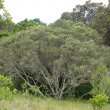
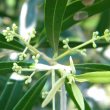
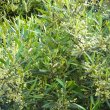
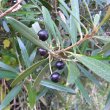
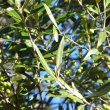
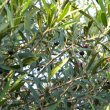
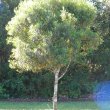
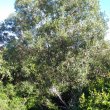
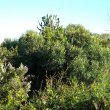


Comments
indigenous plants
Interested in butterfly and bird attracting small trees and shrubs
how to germinete olea africana from seeds
hi there i have a ploblem with germinating of olea seeds
Germinating Olea africana
Hi Jonathan
You are not alone! The seeds can take up to nine months to germinate and often have a very low germination rate unless prepared. First of all make sure that all the outer fruit is removed. The seed then needs to be scarified, meaning that a bit of the hard outer coat is damaged so that moisture can penetrate and the seed will then germinate. You can do this by nicking the seed with a sharp knife or by rubbing a small area of the seed on sandpaper. (This can play havoc with fingers.) After this, the seed can be planted as usual and germination will be up to 90%. You can also crack the whole seed husk very carefully before planting but I find I am a bit rough and damage the delicate insides.
A last caution is to make sure the seeds have not been infested by bugs. I do this by cracking a few of the seeds right open to make sure that there is actually a seed inside and not a pupa or other icky thing. I have in the past made this mistake with quite a few types of seed where I have waited for months for germination, only to realise that the seeds
were not viable in the first place.
I hope this helps and you have better results.
Kind regards
Lorraine
olive tree
I Lorraine, I have a olive tree (Mission) the fruits are very big, but the yield not the same every year (is this normal), is their anything I can do to encourage the flowers to stay, the tree is about 4 -5 years old, thanks
Non-indigenous Olive trees
Hi Maria
I don't know very much about olive trees grown for fruit, but we did have one in our garden where I grew up. Our tree only fruited every second year. I did some research and here is what I discovered.
Although the Mission olive fruits while quite young, the yield of olives is inconsistent, meaning that you will have some good years and some not so good. The pollen produced by Mission olive trees is of a low quality so it does not self-pollinate well - no pollination, no fruit. To improve the yield of fruit, you need another variety of olive tree to cross-pollinate with the Mission olive. (The variety suggested is 'Frantoio'.)
This will explain why the flowers fall off. They are not being pollinated.
I got most of the information from this site, which I found very interesting: http://www.olivessa.co.za/olive-trees-2/
Hope this helps.
Kind regards
Lorraine
olive tree
Thank you, and I concur with what you say about having only fruit every second year, and explains the pollination issue
growth observed of flower and stem in olive in spring to summer
I am interested to learn about growth observed in olive trees during spring to harvest. when does the vegetative growth start and at what stage does the flower growth start?
Olive trees for hedges
Hi, which olive tree would be best suitable for a hedge - we live in Pretoria. Wild Olive?
Olive trees for hedges
Hi Riana
Yes, the indigenous Olea europaea subsp. Africana is an excellent choice for a large garden or property, small holding, farm, sport's club, estate and so on. For a smaller garden it may easily take up too much space and create too much shade, as you can expect it to grow to a height of 8 meters or more.
Kind regards
Lorraine
Germination Olea Africana seeds
Seeds seem to germinate more readily when strewn with granite chips.There is app an enzyme that prevent too many seeds germinating in a specific area- anybody with more info?Scarification can be done by adding glass from a broken car windscreen into a container with seeds and shake untill most seeds are affected
Seed germinating tips
Hi Niel
Thanks for your comment. Your scarification idea sounds a lot less work than when I first tried this: I rubbed every seed on sand-paper, one by one! Good results but very time-consuming - never mind the raw fingertips.
Kind regards
Lorraine
wild olive tree
Hi, dumb question - why is the mamba ( black ) always found in wild olive bushes in the wild?, just an observation.
thanks
Black mambas
Hi Cobus
I have never heard about this and as I am a plant person not a snake person, I cannot answer you. Perhaps you should try a site dealing with snakes.
Kind regards
Lorraine
Olea europaea L. subsp. africana
Good day
I have an Olea europaea subsp. africana. It is about 5 years old. This year there were no flowers on the tree. I have noted a lot of dead branches. From a distance I can look through the tree. Is the tree sick? Is this condition treatable? What should be done? Should it be chopped?
Most of our trees and plants in the garden are indigenous.
Thank you
Derick
Ailing Wild olive
Hi Derick
Many of my Wild olive trees flower one year and not the next so I would not be too concerned about that. I am unable to make any sort of assessment of your tree with so little information. Perhaps if you send some photos of the tree, branches and leaves, where you live and weather conditions for the last six months or so, I might be able to be of further help.
Kind regards
Lorraine
Wild olive
Hi there
I have 4 wild olive trees in my garden. 3 of these leaves are up right and is growing nicely.
But I have one olive with droopy leaves and branches. Want to know if this is a wild olive or
Some other tree?
Wild olive with drooping stems
Hi Wanda
It certainly looks like a wild olive. Is it perhaps possible that the tree, being situated in a corner, is getting more shade than the other trees? The placement of the drainage pipe could also be creating a wetter environment. You could try cutting the longer stems back by about a third of their length.
A note of warning
It may be wise to consider the following information that I found while researching recently, on the website of PlantZAfrica (http://www.plantzafrica.com/frames/plantsfram.htm),
"Don't plant it too close to walls, patios or swimming pools, the root system can sometimes be aggressive."
As Wild olives can grow to a height of 15 meters and have a wide-spreading crown of 8 or more meters across, (see the pictures above) they should be planted at least 8 to 10 meters away from a permanent structure.
Kind regards
Lorraine
wild olive
How easy is it to grow wild olive trees from cuttings, using a rooting hormone or something similar ?
If possible is it not a better and faster way than from seeds ?
thanks,
Matt
Olive trees from cuttings
Hi Matt
Yes, growing from cuttings is a faster way to get young plants growing.
According to Plantzafrica (http://www.plantzafrica.com/frames/plantsfram.htm), "Propagate it from seed or from hardwood cuttings. Sow fresh seed in river sand. Treat cuttings with a rooting hormone."
Kind regards
Lorraine
Discuss this plant
Share knowledge, ask a question or give an experience.